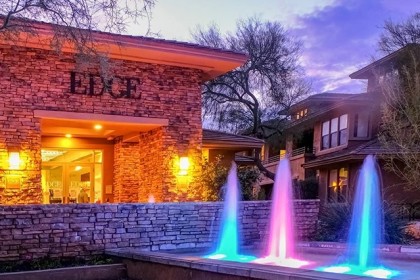
First impressions matter whether you own a home or run a business. The curb appeal of your property sets the tone for what’s inside, and landscape lighting is a key element in making that first impression memorable. At North Star Outdoor Lighting, we understand how essential it is to highlight your property’s best features. Properly installed landscape lighting not only enhances the beauty of your surroundings but also increases safety and security. There are various types of landscape lighting and design considerations to keep in mind. Both of these come with numerous benefits for a well-lit exterior. From enhancing architectural details to guiding visitors safely, North Star Outdoor Lighting can help you create a captivating, inviting atmosphere that leaves a lasting impression.
Understanding the Basics of Landscape Lighting
Landscape lighting is the strategic use of outdoor lighting fixtures to illuminate and enhance the exterior of residential and commercial properties. Its primary purpose is to highlight the architectural features, landscaping elements, and pathways, creating a visually appealing and safe environment after dark. Properly executed landscape lighting not only improves the aesthetic appeal of a property but also increases its functionality, making outdoor spaces usable during evening hours.
When it comes to residential landscape lighting, the focus is often on creating a warm, welcoming ambiance that enhances curb appeal and highlights key features like gardens, trees, and architectural details. In contrast, commercial landscape lighting often emphasizes security, visibility, and brand presence, ensuring that businesses are well-lit and inviting to customers after dark.
Types of Landscape Lighting
Pathway Lighting: Pathway lighting is essential for guiding visitors safely to the entrance of a property. It illuminates walkways, driveways, and garden paths, preventing accidents while adding a touch of elegance to the landscape. By using low-voltage landscape lighting fixtures along pathways, you can create a welcoming atmosphere that draws attention to the natural beauty of your garden or yard.
Accent Lighting: Accent lighting is used to highlight specific architectural features or landscaping elements, such as statues, fountains, or trees. This type of lighting adds depth and dimension to a property, making it stand out. LED landscape lighting is often used for accent lighting due to its energy efficiency and versatility.
Security Lighting: Security lighting serves the dual purpose of enhancing safety and aesthetics. By illuminating dark areas around a property, security lighting deters potential intruders while also making the space more visually appealing. Solar-powered outdoor lights can be an eco-friendly option for security lighting, providing reliable illumination without increasing energy costs.
Wall Wash Lighting: Wall wash lighting is a technique used to evenly illuminate large walls or building facades, adding depth and a sense of grandeur to the property. This type of lighting is particularly effective for commercial buildings, where creating an impressive visual impact is key.
Uplighting and Downlighting: Uplighting involves placing lights at ground level to shine upward, often used to highlight trees, statues, or the exterior of a building. Downlighting, on the other hand, involves placing lights higher up to shine downward, mimicking natural light and enhancing security. Both techniques can be used in combination to create a balanced and visually stunning landscape lighting design that enhances both residential and commercial properties.
Planning Your Landscape Lighting Design
Identifying Key Features
The first step in any landscape lighting project is to assess your property and identify the key features that you want to highlight. Focus on areas that will benefit most from illumination, such as pathways, entrances, gardens, and architectural details. Pathway lighting, for example, not only guides visitors safely to your door but also adds a welcoming glow that enhances your building’s curb appeal. Similarly, accent lighting can be used to draw attention to beautiful landscaping elements or unique architectural features, making them stand out even after the sun goes down.
Considering Building Architecture
When planning your landscape lighting, it’s essential to consider the architecture of your building. The goal is to integrate lighting in a way that complements the design of your property. For example, wall-wash lighting can be used to highlight the texture of stone or brick facades, adding depth and character to your building’s exterior. If your property has large trees or distinctive architectural features, uplighting and downlighting techniques can be employed to emphasize these elements, creating a cohesive and aesthetically pleasing design.
Setting Goals
Aesthetic Goals
Setting aesthetic goals will create the desired mood or ambiance for your outdoor spaces. Whether you want to create a warm, inviting atmosphere with soft lighting or a dramatic effect with bold accent lights, your lighting choices will significantly impact the overall feel of your property. Think about how different types of landscape lighting, such as pathway and accent lighting, can work together to achieve your aesthetic goals.
Practical Goals
In addition to aesthetics, it’s important to set practical goals for your landscape lighting. These might include ensuring the safety and security of outdoor spaces, making them usable after dark, and enhancing visibility around your property. Security lighting, for example, can deter intruders while also providing ample light for nighttime activities. By balancing both aesthetic and practical goals, you can create a landscape lighting design that is both beautiful and functional.
Choosing the Right Lighting
LED vs. Halogen
When it comes to choosing the right lighting for your property, the decision between LED and halogen lights is a crucial one. LED landscape lighting is known for its energy efficiency, longevity, and lower operating costs, making it a popular choice for both residential and commercial properties. Halogen lights, on the other hand, offer a warm, natural glow but are less energy-efficient and have a shorter lifespan. While LEDs may have a higher upfront cost, their long-term savings and environmental benefits often outweigh the initial investment.
Solar-Powered Landscape Lighting
Solar-powered outdoor lights are another option to consider, especially for those looking to reduce their environmental footprint. These lights are powered by the sun, making them a cost-effective and eco-friendly solution. However, solar lighting solutions can be limited by their dependency on sunlight, making them less reliable in areas with frequent cloud cover or shading. Despite these limitations, solar-powered lighting can be an excellent choice for accent lighting in gardens or along pathways.
Color Temperature
The color temperature of your lighting also plays a significant role in the overall appearance of your property. Warm lighting (with a color temperature of around 2700K to 3000K) creates a cozy, inviting atmosphere, while cool lighting (with a color temperature above 4000K) can give your property a more modern, crisp look. The choice between warm and cool lighting should be based on the mood you want to create and how it complements your building’s architecture and landscaping.
Planning the Layout of Your Landscape Design
Balancing Light and Shadow
One of the key techniques in landscape lighting design is balancing light and shadow. Properly placed lighting can create depth and dimension, making your property appear more dynamic and visually interesting. For instance, using uplighting to illuminate tall trees while allowing shadows to fall on the ground can create a dramatic and striking effect.
Avoiding Over-illumination
It’s important to avoid over-illumination, as too much light can make your property look harsh and uninviting. Instead, aim for subtlety, using just enough light to highlight key features without overwhelming the senses. Soft pathway lighting, for instance, can guide visitors without creating excessive brightness, ensuring that your landscape remains elegant and understated.
Layering Light
Layering light involves using multiple types of lighting to create a cohesive and balanced design. By combining pathway lighting, accent lighting, and security lighting, you can achieve a layered effect that enhances the beauty, safety, and functionality of your outdoor spaces. This approach allows you to address both aesthetic and practical goals, ensuring that your landscape lighting design is both visually appealing and highly effective.
DIY vs. Professional Installation
Pros and Cons of DIY
Opting for a DIY approach to landscape lighting can be appealing, especially when considering cost savings. Installing your own outdoor lighting allows you to control the budget, choose your fixtures, and create a design that suits your taste. However, DIY installations come with potential pitfalls. Without the necessary expertise, you may encounter issues such as improper placement, over-illumination, or inadequate electrical safety. Additionally, DIY projects can be time-consuming, and mistakes made during installation can lead to costly repairs or replacements in the long run.
Benefits of Hiring a Professional
Hiring a professional for your landscape lighting installation offers several advantages. Professionals bring expertise in design and installation, ensuring that your lighting plan enhances your property’s curb appeal while also being functional and safe. They have the knowledge to properly position lights, select the right fixtures, and ensure that the installation meets local electrical codes and regulations. Moreover, a professional can troubleshoot potential issues during the installation process, providing peace of mind and delivering optimal results that DIY installations may lack.
Safety and Compliance
Electrical Safety
Electrical safety needs to be considered in landscape lighting installation. Ensuring that your lighting system meets local codes and regulations is essential to prevent hazards such as electrical shorts, shocks, or fires. Professional installers are well-versed in these codes and can ensure that your installation is compliant, providing a safe and reliable lighting system for your property. Even in a DIY project, it’s important to thoroughly research and adhere to these standards to avoid potential safety risks.
Waterproofing and Durability
Outdoor lighting fixtures are exposed to the elements, making waterproofing and durability key concerns. Using weather-resistant materials, such as fixtures rated for outdoor use, helps to ensure that your landscape lighting remains functional and attractive over time. Proper waterproofing also prevents moisture from infiltrating electrical components, reducing the risk of damage and extending the life of your lighting system. Professionals can recommend and install the most durable options for your specific environment, ensuring that your investment lasts.
Maintenance Tips
Regular Cleaning
Maintaining your landscape lighting involves regular cleaning to keep fixtures free from dirt, debris, and buildup that can dull their brightness. Over time, outdoor lights can accumulate dust, pollen, and other environmental particles, reducing their effectiveness. A gentle wipe-down with a soft cloth and mild soap can help maintain the appearance and functionality of your lighting fixtures. Regular cleaning not only keeps your lighting bright but also prolongs the lifespan of the fixtures.
Replacing Bulbs and Batteries
To ensure that your landscape lighting continues to function efficiently, it’s important to replace bulbs and batteries as needed. LED lights typically have a long lifespan, but they will eventually need replacement. Similarly, solar-powered lights may require new batteries to maintain optimal performance. Establishing a schedule for checking and replacing these components helps maintain consistent brightness and prevents any sections of your property from becoming dimly lit.
Seasonal Adjustments
As the seasons change, so too should your landscape lighting. Seasonal adjustments ensure that your lighting design continues to enhance your property throughout the year. In the summer, you may want to focus on illuminating outdoor living areas, while in the winter, you might emphasize pathways and driveways. Adjusting the angle of your lights, changing the color temperature, or adding additional fixtures for holiday displays are all ways to keep your landscape lighting relevant and effective year-round. Regularly evaluating and adjusting your lighting design ensures that it continues to meet your aesthetic and practical goals, regardless of the season.
Enhanced Aesthetic Appeal with Landscape Lighting
Highlighting Architecture
One of the most impactful ways to enhance your building’s aesthetic appeal is by using landscape lighting to highlight its architectural features. Whether it’s accentuating the intricate details of a historical facade or bringing modern design elements to life, strategically placed lighting can emphasize the unique aspects of your building. Uplighting can be used to cast dramatic shadows on textured surfaces, while wall-wash lighting provides a soft, even glow that enhances the overall structure without overpowering it. For instance, illuminating columns, arches, or entryways can create a stunning visual effect that draws attention and adds character to your property.
Showcasing Through Landscaping Lighting
Landscape lighting also helps in showcasing the beauty of your garden, trees, and other landscaping features. By carefully positioning lights to accentuate the texture and color of plants, you can create a vibrant, inviting environment that stands out, even at night. Pathway lighting can guide the eye along garden trails, while spotlights can highlight focal points such as statues or water features. This not only enhances the visual appeal of your property but also allows you to enjoy your outdoor spaces long after sunset.
Improved Security
Deter Criminal Activity
Well-designed landscape lighting is not just about aesthetics; it also significantly improves security. Numerous studies have shown that well-lit properties are less likely to be targeted by criminals. Illuminating dark areas around your building, such as entrances, driveways, and walkways, can deter potential intruders by increasing visibility and eliminating hiding spots. Security lighting can be strategically placed to ensure that every corner of your property is visible, providing peace of mind and enhancing safety.
Increased Visibility
Increased visibility is another benefit of landscape lighting, as it helps prevent accidents and injuries. Well-lit walkways, stairs, and entry points ensure that visitors and occupants can navigate your property safely, reducing the risk of trips, falls, and other mishaps. Additionally, properly illuminated outdoor spaces can make your property more accessible and welcoming, particularly for those with mobility issues.
Increased Property Value with Landscape Lighting
ROI on Lighting Investments
Investing in landscape lighting can yield a significant return on investment (ROI) by boosting your property’s value. A well-lit exterior not only enhances curb appeal but also signals to potential buyers that the property is well-maintained and cared for. Properties with professionally installed landscape lighting often stand out in the real estate market, attracting more interest and potentially leading to higher sale prices. The initial cost of installation is often offset by the increase in property value, making it a wise investment for homeowners and business owners alike.
Appeal to Potential Buyers
For potential buyers, landscape lighting is a desirable feature that can make a property more attractive. A beautifully lit exterior creates a lasting impression and can be the deciding factor for buyers when choosing between properties. It also adds functionality, allowing homeowners to use outdoor spaces at night, which can be particularly appealing for those who enjoy entertaining or spending time outdoors. In a competitive real estate market, the presence of well-designed landscape lighting can set your property apart from others, making it a more appealing option.
Energy Efficiency and Sustainability
Eco-Friendly Lighting Options
In today’s environmentally conscious world, eco-friendly lighting options are more important than ever. LED landscape lighting and solar-powered lights are two of the most sustainable choices available. LEDs use significantly less energy than traditional bulbs and have a longer lifespan, reducing both energy consumption and the frequency of replacements. Solar-powered outdoor lights harness the sun’s energy, eliminating the need for electrical wiring and reducing your carbon footprint. These eco-friendly options not only benefit the environment but also contribute to lower energy bills.
Cost Savings Over Time
While the initial investment in energy-efficient lighting may be higher than traditional options, the long-term cost savings can be substantial. LED lights, for example, consume up to 80% less energy than incandescent bulbs, leading to significant reductions in electricity costs. Additionally, their longer lifespan means fewer replacements and lower maintenance costs. Solar lighting, although dependent on sunlight, offers virtually no operating costs once installed. By choosing energy-efficient landscape lighting, property owners can enjoy a beautifully illuminated space while also benefiting from reduced utility bills and lower overall expenses.
Upgrade Your Curb Appeal
Landscape lighting is a powerful tool for boosting your building’s curb appeal, enhancing both the aesthetics and functionality of your outdoor spaces. From highlighting architectural features and showcasing landscaping to improving security and increasing property value, the benefits of well-designed lighting are undeniable. By choosing energy-efficient options like LED or solar-powered lights, you can also contribute to sustainability while enjoying cost savings over time.
Now is the perfect time to assess your property and consider the impact that landscape lighting could have. Whether you’re looking to enhance beauty, improve safety, or increase property value, installing or upgrading your lighting is a smart investment. Contact a professional for a consultation, or visit our website at North Star Outdoor Lighting to explore your options and get started on transforming your property today.














































